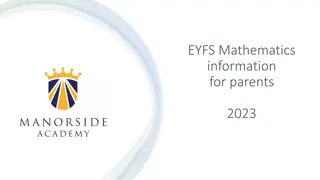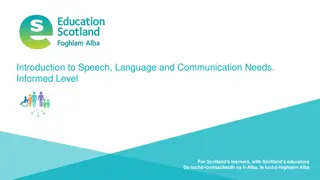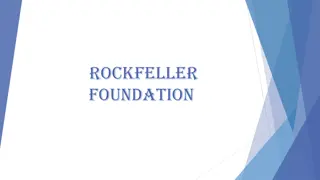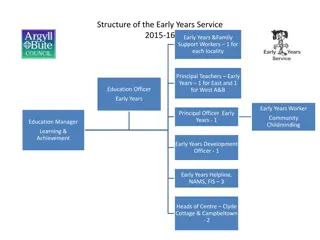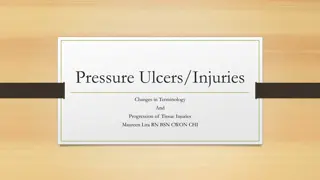Early Years Foundation Stage Communication and Language Development Progression
Children's communication and language skills are essential for their overall development. This progression guide outlines the checkpoints from Nursery to Reception stage, focusing on spoken language, conversation skills, vocabulary development, and listening abilities. It emphasizes building a language-rich environment through interactions with adults and peers to enhance children's communication skills effectively.
Download Presentation

Please find below an Image/Link to download the presentation.
The content on the website is provided AS IS for your information and personal use only. It may not be sold, licensed, or shared on other websites without obtaining consent from the author. Download presentation by click this link. If you encounter any issues during the download, it is possible that the publisher has removed the file from their server.
E N D
Presentation Transcript
Early Years Foundation Stage Civitas Academy Progression Checkpoints
Communication and Language Progression Checkpoints EYFS Statutory Educational Programme The development of children s spoken language underpins all seven areas of learning and development. Children s back-and-forth interactions from an early age form the foundations for language and cognitive development. The number and quality of the conversations they have with adults and peers throughout the day in a language-rich environment is crucial. By commenting on what children are interested in or doing, and echoing back what they say with new vocabulary added, practitioners will build children s language effectively. Nursery On Entry Nursery Autumn Nursery Spring Nursery Summer Start to talk about own feelings. Developing conversation skills but may jump topics. Listen to simple stories and understand what is happening. Identify familiar objects and properties. Understand and act on longer sentences. Understand simple questions of who, what, where. Know a few songs and rhymes. Express needs and wants. Listen to longer stories, recalling some main parts. Understand two part questions and instructions. Talk about familiar books. Begin to use newly introduced vocabulary. Begin to pay attention to more than one thing at a time. Understand why questions. Begin to organise play through talk. Know several songs and rhymes. Enjoy listening to stories and remember most key points. Be able to start and continue a conversation, express a point of view and debate with others. Use longer sentences of four to six words. Use a wider range of vocabulary. Develop communication and pronunciation but still with some errors. Talk in some detail about books read. Tell a long story. Reception On Entry Reception Autumn Reception Spring Reception Summer Be able to start and continue a conversation, express a point of view and debate with others. Use longer sentences of four to six words. Use a wider range of vocabulary. Develop communication and pronunciation but still with some errors. Talk in some detail about books read. Tell a long story. Understand how to listen carefully and why listening is important. Learn new vocabulary and use it in context. Begin to ask questions to find out more and clarify understanding. Engage in storytimes through attentive listening and discussion to build familiarity and understanding. Engage in conversations exploring non- fiction topics, developing knowledge and vocabulary. Use talk to help work out problems and organise thinking and actions. Articulate their ideas and thoughts in well-formed sentences. Retell stories in own words, drawing on key phrases from the text. Present to a group using well articulated sentences and detailed descriptions. Join ideas together using connectives. Use rich vocabulary in different contexts. Understand how to listen carefully to others with attention. Confidently ask questions to find out more and extend understanding. Reception Early Learning Goals (ELGs) Listening, Attention and Understanding Listen attentively and respond to what they hear with relevant questions, comments and actions when being read to and during whole class discussions and small group interactions. Make comments about what they have heard and ask questions to clarify their understanding. Hold conversation when engaged in back-and-forth exchanges with their teacher and peers. Speaking Participate in small group, class and one-to-one discussions, offering their own ideas, using recently introduced vocabulary. Offer explanations for why things might happen, making use of recently introduced vocabulary from stories, non- fiction, rhymes and poems when appropriate. Express their ideas and feelings about their experiences using full sentences, including use of past, present and future tenses and making use of conjunctions, with modelling and support from their teacher. Linked Curriculum Goals Nursery Engage in back and forth conversations. Reception Present, ask questions and make relevant comments.
Personal, Social and Emotional Development Progression Checkpoints EYFS Statutory Educational Programme Children s personal, social and emotional development (PSED) is crucial for children to lead healthy and happy lives, and is fundamental to their cognitive development. Underpinning their personal development are the important attachments that shape their social world. Strong, warm and supportive relationships with adults enable children to learn how to understand their own feelings and those of others. Nursery On Entry Nursery Autumn Nursery Spring Nursery Summer Develop friendships with children. Notice and ask questions about others. Begin to show control over self. Manages transitions from home to nursery with support. Increasingly able to talk about and manage their emotions. Develops sense of membership and responsibility to the class. Follows some rules. Manages transitions from home to nursery. Developed relationships within the class. More confident in new situations. Select and use activities and resources. Use accurate vocabulary when talking about their feelings. Help find solutions to conflicts with others. Extend and elaborate play ideas when engaging with others. Increasingly follows rules showing understanding to why they are important. More outgoing with unfamiliar people. Begin to understand how others might be feeling. Talk with others to solve conflicts which arise. Be appropriately assertive. Independently follow rules. Use a wider range of vocabulary. Persevere with difficulties. Reception On Entry Reception Autumn Reception Spring Reception Summer Talk with others to solve conflicts which arise. Be appropriately assertive. Independently follow rules. Use a wider range of vocabulary. Persevere with difficulties. See themself as a valuable individual. Build constructive and respectful relationships. Identify and regulate their own feelings socially and emotionally and consider the feelings of others. Show resilience and perseverance in the face of challenge. Manage their own needs. Know and talk about the different factors that support their overall health and wellbeing. Reception Early Learning Goals (ELGs) Self Regulation Show an understanding of their own feelings and those of others, and begin to regulate their behaviour accordingly. Set and work towards simple goals, being able to wait for what they want and control their immediate impulses when appropriate. Give focused attention to what the teacher says, responding appropriately even when engaged in activity, and show an ability to follow instructions involving several ideas or actions. Managing Self Be confident to try new activities and show independence, resilience and perseverance in the face of challenge. Explain the reasons for rules, know right from wrong and try to behave accordingly. Manage their own basic hygiene and personal needs, including dressing, going to the toilet and understanding the importance of healthy food choices. Building Relationships Work and play cooperatively and take turns with others. Form positive attachments to adults and friendships with peers. Show sensitivity to their own and to others needs. Linked Curriculum Goals Nursery Settle in and become a confident learner within the class community. Reception Coordinate a group game alongside classmates.
Physical Development Progression Checkpoints EYFS Statutory Educational Programme Physical activity is vital in children s all-round development, enabling them to pursue happy, healthy and active lives. Gross and fine motor experiences develop incrementally throughout early childhood, starting with sensory explorations and the development of a child s strength, coordination and positional awareness through tummy time, crawling and play movement with both objects and adults. Nursery On Entry Nursery Autumn Nursery Spring Nursery Summer Enjoy starting to kick, throw and catch balls. Build independently with a range of appropriate resources. Clap and stamp to music. Use large and small motor skills to do things independently, for example manage buttons and zips, and pour drinks. Learn to use the toilet with help then independence. Develop movement in terms of balancing, riding and ball skills. Use large-muscle movements to wave flags/streamers, paint and make marks. Match type of movement to activities. Use one-handed tools and equipment. Start to eat independently, learning to use a knife & fork. Increasingly independent with dressing/undressing. Begin to recognise danger, seeking support/comfort from significant adults. Go up steps and stairs, or climb up apparatus. Increasingly able to use and remember sequences and patterns of movements which are related to music or rhythm. Choose the right resources to carry out their own plan. Use a comfortable grip with good control when holding pens and pencils. Increasingly independent in meeting their own care needs. Skip, hop, stand on one leg and hold a pose. Use a range of large-muscle movements. Begin to negotiate space. Start taking part in some group activities which they make up. Collaborate to manage large items. Recognise some safety considerations. Show a preference for a dominant hand. Make healthy choices about food, drink, activity and toothbrushing. Reception On Entry Reception Autumn Reception Spring Reception Summer Skip, hop, stand on one leg and hold a pose. Use a range of large-muscle movements. Begin to negotiate space. Start taking part in some group activities which they make up. Collaborate to manage large items. Recognise some safety considerations. Show a preference for a dominant hand. Make healthy choices about food, drink, activity and toothbrushing. Develop the skills needed to manage the school day successfully. Refine the fundamental movement skills already acquired. Progress towards a more fluent style of moving. Develop overall body-strength, balance, coordination and agility. Develop small motor skills to use tools competently, safely & confidently. Know and talk about factors that support overall health & wellbeing. Develop overall body-strength, balance, coordination and agility needed to engage successfully with future physical education sessions and other physical disciplines. Use a range of large and small apparatus. Develop confidence, competence, precision and accuracy when engaging in ball activities. Further develop and refine a range of ball skills. Use core muscle strength to achieve a good posture when sitting at a table or sitting on the floor. Combine different movements with ease and fluency. Confidently and safely use a range of large and small apparatus. Develop the foundations of a handwriting style which is fast, accurate and efficient. Reception Early Learning Goals (ELGs) Gross Motor Skills Negotiate space and obstacles safely, with consideration for themselves and others. Demonstrate strength, balance and coordination when playing. Move energetically, such as running, jumping, dancing, hopping, skipping and climbing. Fine Motor Skills Hold a pencil effectively in preparation for fluent writing using the tripod grip in almost all cases. Use a range of small tools, including scissors, paint brushes and cutlery. Begin to show accuracy and care when drawing. Linked Curriculum Goals Nursery Explore an obstacle course using a range of movement. Reception Navigate the climbing frame effectively.
Reading Progression Checkpoints EYFS Statutory Educational Programme It is crucial for children to develop a life-long love of reading. Reading consists of two dimensions: language comprehension and word reading. Language comprehension (necessary for both reading and writing) starts from birth. It only develops when adults talk with children about the world around them and the books (stories and non-fiction) they read with them, and enjoy rhymes, poems and songs together. Skilled word reading, taught later, involves both the speedy working out of the pronunciation of unfamiliar printed words (decoding) and the speedy recognition of familiar printed words. Nursery On Entry Nursery Autumn Nursery Spring Nursery Summer Enjoy sharing books with an adult. Pay attention and respond to pictures or words. Ask questions about the book. Make comments and shares their own ideas. Notice some print, such as the first letter of their name, a bus or door number, or a familiar logo. Understand the five key concepts about print: print has meaning, the names of the different parts of a book, print can have different purposes, page sequencing and we read English text from left to right and from top to bottom. Develop their phonological awareness, so that they can: spot and suggest rhymes and count or clap syllables in a word. Engage in extended conversations about stories, learning new vocabulary. Develop their phonological awareness, so that they can recognise words with the same initial sound. Reception On Entry Reception Autumn Reception Spring Reception Summer Engage in extended conversations about stories, learning new vocabulary. Develop their phonological awareness, so that they can recognise words with the same initial sound. Re-read books to build up their confidence in word reading, their fluency and their understanding and enjoyment. Beginning to read words which include set 1 single sounds. Read VC + CVC words. Blend sounds into words. Re-read books to build up their confidence in word reading, their fluency and their understanding and enjoyment. Engage in fiction and non fiction books independently. Read words which include set 1 single sounds and digraphs. Read CVCC + CCVC words. Blend sounds into words. Read simple phrases and sentences. Read a few set 1 tricky words. Re-read books to build up their confidence in word reading, their fluency and their understanding and enjoyment. Read words which include set 1+2 sounds. Read longer words. Read simple phrases and sentences. Read some set 1+2 tricky words. Reception Early Learning Goals (ELGs) Comprehension Demonstrate understanding of what has been read to them by retelling stories and narratives using their own words and recently introduced vocabulary. Anticipate (where appropriate) key events in stories. Use and understand recently introduced vocabulary during discussions about stories, non- fiction, rhymes and poems and during role play. Word Reading Say a sound for each letter in the alphabet and at least 10 digraphs. Read words consistent with their phonic knowledge by sound- blending. Read aloud simple sentences and books that are consistent with their phonic knowledge, including some common exception words. Linked Curriculum Goals Nursery Make up a story. Reception Embrace a love of reading.
Writing Progression Checkpoints EYFS Statutory Educational Programme Language comprehension (necessary for both reading and writing) starts from birth. It only develops when adults talk with children about the world around them and the books (stories and non-fiction) they read with them, and enjoy rhymes, poems and songs together. Writing involves transcription (spelling and handwriting) and composition (articulating ideas and structuring them in speech, before writing). Nursery On Entry Nursery Autumn Nursery Spring Nursery Summer Draw freely. Some marks are given meaning. Imitate writing with a variety of shapes and symbols. Distinguish between different marks made. Write letter like forms. Use mark making in play. Write/match first letter of own name. Intentional mark making with ascribed meaning. Write strings of letters. Write initial sounds for some words. Write/match some of own name. Some letters are recognisable. Reception On Entry Reception Autumn Reception Spring Reception Summer Intentional mark making with ascribed meaning. Write strings of letters. Write/match initial sounds for some words. Write some of own name. Some letters are recognisable. Write own name confidently. Beginning to write words which include set 1 single sounds. Begin to write VC + CVC words. Some letters are correctly formed and most others are recognisable. Write words which include set 1 single sounds and digraphs. Write CVCC + CCVC words. Words are phonetically plausible matching spoken word. Write a few set 1 tricky words. Write captions. Mostly readable by others. Most letters are correctly formed and others are recognisable. Write words which include set 1+2 sounds. Write longer words. Words are phonetically plausible. Write some set 1+2 tricky words. Write sentences which can be read back and by others. Begin to use capital letter and full stop. Read sentence back to check for accuracy and sense. All letters are correctly formed. Reception Early Learning Goals (ELGs) Writing Write recognisable letters, most of which are correctly formed. Spell words by identifying sounds in them and representing the sounds with a letter or letters. Write simple phrases and sentences that can be read by others. Linked Curriculum Goals Nursery Write the first 3 letters of own name. Reception Write a simple story.
Mathematics Progression Checkpoints EYFS Statutory Educational Programme Developing a strong grounding in number is essential so that all children develop the necessary building blocks to excel mathematically. Children should be able to count confidently, develop a deep understanding of the numbers to 10, the relationships between them and the patterns within those numbers. Nursery On Entry Nursery Autumn Nursery Spring Nursery Summer Take part in finger rhymes with numbers. Compare amounts, saying lots, more or same. Count in everyday contexts, can skip numbers. Squeeze into different types of spaces. Build with a range of resources. Complete inset puzzles. Compare sizes, weights etc. using gesture/language - bigger/little/high/ heavy. Notice and arrange patterns. Compare quantities using language: more, fewer. Talk about & identify patterns around them e.g. stripes on clothes. Extend and create ABAB patterns. Begin to describe a sequence of events, using first/then. Use informal language like pointy , spotty etc. Select shapes appropriately: a triangular for a roof etc. Make observation relating to size, mass & capacity. Fast recognition of up to 3 objects, without counting (subitising). Say one number for each item in order to 5. Know the last number when counting tells you the total (cardinal principle). Understand position through words alone. Make comparisons between objects relating to length, weight & height. Combine shapes to make new ones. Recite numbers past 5. Show finger numbers up to 5. Experiment with own symbols, marks & numerals. Link numerals and amounts. Solve real world maths problems with numbers up to 5. Describe a familiar route. Discuss routes and locations, using words like in front of and behind . Explore 2D/3D shapes using language: sides, corners, straight, flat. Reception On Entry Reception Autumn Reception Spring Reception Summer Link numerals and amounts. Solve real world maths problems with numbers up to 5. Describe a familiar route. Discuss routes and locations, using words like in front of and behind . Combine shapes to make new ones. Extend and create ABAB patterns and notice and correct an error. Begin to describe a sequence of events, real or fictional, using words such as first/then. Count objects/actions/sounds. Subitise. Link numerals with its cardinal value. Count beyond 10. Compare numbers. Understand the one more/one less relationship between numbers. Explore the composition of numbers to 10. Select & manipulate shapes to develop spatial reasoning skills. Compose & decompose shapes (recognise shapes have other shapes within). Continue & create repeating patterns. Compare length, weight & capacity. Count objects, actions & sounds. Subitise. Link numerals with its cardinal value. Count beyond 15. Compare numbers. Understand the one more/one less relationship between numbers. Explore the composition of numbers to 10. Automatically recall number bonds for numbers 0 5. Compose and decompose shapes (recognise shapes have other shapes within it). Continue and create repeating patterns. Compare length, weight and capacity. Count objects, actions & sounds. Subitise. Link numerals with its cardinal value. Count beyond 20. Compare numbers. Understand the one more/one less relationship between numbers. Explore the composition of numbers to 10. Automatically recall number bonds for numbers 0 10. Compose and decompose shapes (recognise shapes have other shapes within it). Continue and create repeating patterns. Compare length, weight and capacity. Reception Early Learning Goals (ELGs) Number Have a deep understanding of number to 10, including the composition of each number. Subitise (recognise quantities without counting) up to 5. Automatically recall (without reference to, counting or other aids) number bonds up to 5 (including subtraction) and some number bonds to 10, including double facts. Number Patterns Verbally count beyond 20, recognising the pattern of the counting system. Compare quantities up to 10 in different contexts, recognising when one quantity is greater, less or the same. Explore and represent patterns within numbers up to 10, including evens & odds, double facts & how quantities can be distributed equally. Linked Curriculum Goals Nursery Build a deep understanding of numbers to 5. Reception Build a deep understanding of numbers to 10.
Understanding the World Progression Checkpoints EYFS Statutory Educational Programme Understanding the world involves guiding children to make sense of their physical world and their community. The frequency and range of children s personal experiences increases their knowledge and sense of the world around them from visiting parks, libraries and museums to meeting important members of society such as police officers, nurses and firefighters. In addition, listening to a broad selection of stories, non-fiction, rhymes and poems will foster their understanding of our culturally, socially, technologically and ecologically diverse world. As well as building important knowledge, this extends their familiarity with words that support understanding across domains. Enriching and widening children s vocabulary will support later reading comprehension. Nursery On Entry Nursery Autumn Nursery Spring Nursery Summer Make connections between the features of their family and other families. Notice differences between people. Explore and respond to different natural phenomena in their setting and on trips. Seeks to acquire basic skills in turning on and operating some digital equipment. Operates mechanical toys. Show interest in different occupations. Begin to make sense of their own life- story & family s history. Use senses in exploration of natural materials. Explore materials with similar/different properties. Talk about what they see, using a wide vocabulary. Explore how things work. Begin to understand the need to respect/care for the natural environment & living things. Shows an interest in technological toys, real objects and touchscreen devices. Skilled in making toys work. Continue to develop positive attitudes about the differences between people. Begin to make sense of their own life- story & family s history. Explore materials with similar/different properties. Explore different forces they can feel. Plant seeds and care for growing plants. Talk about what they see, using a wide vocabulary. Knows how to operate simple equipment. Know there are different countries & talk about differences experienced or seen. Begin to make sense of own life-story and family history. Value self as an individual. Talk about differences between materials & changes they notice. Understand the key features of some life cycles. Talk about what they see, using a wide vocabulary. Knows that info can be retrieved from digital devices & the internet. Plays with a range of materials to learn cause & effect. Reception On Entry Reception Autumn Reception Spring Reception Summer Know there are different countries & talk about differences experienced or seen. Begin to make sense of own life-story and family history. Value self as an individual. Talk about differences between materials & changes they notice. Understand the key features of some life cycles. Talk about what they see, using a wide vocabulary. Knows that info can be retrieved from digital devices & the internet. Plays with a range of materials to learn cause & effect. Draw information from a simple map. Understand that some places are special to members of their community. Explore the natural world around them. Talk about members of their immediate family & community. Name & describe people who are familiar to them. Complete a simple program on electronic devices. Use ICT hardware to interact with age appropriate computer software. Draw information from a simple map. Understand that some places are special to members of their community. Recognise that people have different beliefs & celebrate special times in different ways. Recognise some similarities & differences between life in this country and life in other countries. Describe what they see, hear & feel whilst outside. Comment on images of familiar situations in the past. Compare & contrast characters from stories & figures from the past. Create content such as a video recording, stories or draw a picture on screen. Draw information from a simple map. Understand that some places are special to members of their community. Recognise that people have different beliefs & celebrate special times in different ways. Recognise some similarities & differences between life in this country and life in other countries. Recognise some environments are different to where they live. Understand effects of changing seasons on the natural world. Comment on familiar situations in the past. Compare & contrast characters from stories & figures from the past. Develop digital literacy skills to interact with technology. Use the internet to retrieve info. Reception Early Learning Goals (ELGs) Past and Present Talk about the lives of the people around them and their roles in society. Know some similarities and differences between things in the past and now, drawing on their experiences and what has been read in class. Understand the past through settings, characters and events encountered in books & storytelling. People, Culture and Communities Describe their immediate environment using knowledge from observation, discussion, stories, non-fiction texts & maps. Know some similarities & differences between different religious and cultural communities in this country, drawing on their experiences and what has been read. Explain some similarities & differences between life in this country and life in other countries, drawing on knowledge from stories, non-fiction texts and maps. The Natural World Explore the natural world around them, making observations and drawing animals & plants. Know some similarities & differences between the natural world around them and contrasting environments, drawing on their experiences and what has been read. Understand some important processes and changes in the natural world around them, including the seasons and changing states of matter. Linked Curriculum Goals Nursery Show curiosity about own life story and what is seen around them. Recite a prayer. Reception Question and appreciate the world around us. Organise a collective worship session.
Expressive Art and Design Progression Checkpoints EYFS Statutory Educational Programme The development of children s artistic and cultural awareness supports their imagination and creativity. It is important that children have regular opportunities to engage with the arts, enabling them to explore and play with a wide range of media and materials. The quality and variety of what children see, hear and participate in is crucial for developing their understanding, self-expression, vocabulary and ability to communicate through the arts. The frequency, repetition and depth of their experiences are fundamental to their progress in interpreting and appreciating what they hear, respond to and observe. Nursery On Entry Nursery Autumn Nursery Spring Nursery Summer Start to make marks intentionally. Explore paint, using body parts, brushes and other tools. Start to develop pretend play. Manipulate and play with different materials. Join in with songs and rhymes with sounds/actions. Explore instruments and play them in different ways. Explore different materials freely, to develop ideas about how to use them & what to make. Take part in simple pretend play. Create closed shapes with continuous lines & begin to use shapes to represent objects. Use drawing to represent ideas like movement or loud noises. Explore colour and colour-mixing. Listen with increased attention to sounds. Join different materials & explore different textures. Make imaginative and complex small worlds with blocks & construction kits. Draw with increasing complexity & detail, such as representing a face with a circle and including details. Explore colour and colour-mixing. Remember and sing entire songs/rhymes. Develop their own ideas and choose materials. Begin to develop complex stories in small world. Show different emotions in drawings/paintings. Explore colour and mixing. Remember and sing many songs and rhymes by heart. Sing the melodic shape of familiar songs. Create own songs, or improvise around one they know. Reception On Entry Reception Autumn Reception Spring Reception Summer Develop their own ideas and choose materials. Begin to develop complex stories in small world. Show different emotions in drawings/paintings. Explore colour and mixing. Remember and sing many songs and rhymes by heart. Sing the melodic shape of familiar songs. Create own songs, or improvise around one they know. Explore, use and refine a variety of artistic effects to express their ideas and feelings. Listen attentively, move to and talk about music, expressing their feelings and responses. Develop storylines in their pretend play. Return to and build on their previous learning, refining ideas and developing their ability to represent them. Sing in a group or on their own, increasingly matching the pitch and following the melody. Create collaboratively sharing ideas, resources & skills. Construct with a plan in mind, reflecting on the outcome & making alterations/improvements. Explore, use & refine a variety of artistic effects to express their ideas & feelings. Talk about dance and performance art, expressing their feelings and responses. Explore & engage in music making and dance, performing solo or in groups. Reception Early Learning Goals (ELGs) Creating with Materials Safely use & explore a variety of materials, tools & techniques, experimenting with colour, design, texture, form & function. Share their creations, explaining the process used. Make use of props & materials when role playing. Being Imaginative and Expressive Invent, adapt and recount narratives and stories with peers and their teacher. Sing a range of well-known nursery rhymes and songs. Perform songs, rhymes, poems and stories with others, and when appropriate try to move in time with music. Linked Curriculum Goals Nursery Recite nursery rhymes from heart and perform one in front of a small group. Draw a face. Reception Perform a story, song, poem or dance to an audience. Construct a mode with a creative plan in mind.




